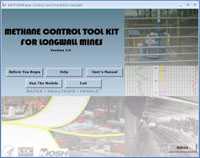Mining Product: MCP - Methane Control and Prediction
Original creation date: July 2009
MCP is a software program that addresses some of the methane and methane control issues in longwall coal mines in the U.S. and other countries.
The download file is a self-extracting executable which will automatically run a setup program. The installation computer should have Microsoft Access® 2003 or later installed.
MCP was developed to address some of the methane and methane control issues in longwall coal mines in the U.S. and other countries. MCP 2.0 is an update to previous versions 1.2 and 1.3 and contains the following two main software model categories:
- ancillary models
- total gas content prediction for coals
- desorbable gas content prediction for coals
- coal measure rock mechanical properties prediction
- methane prediction models
MCP 2.0 offers two sets of methane prediction models:
- Models for Specific U.S. Conditions, which directly relate to specific U.S. longwall mining conditions and to the mining operations in specific states, and
- Models for Other U.S./International Conditions, which are applicable to "other U.S." conditions and also to international projects.
These models have both deterministic and stochastic options to allow better control of design parameters. The application of these modules, separately or in combination, for methane-capture and -control-related problems will help improve safety of mines, provide guidance for effective ventilation practices, and help identify opportunities for capturing and utilizing methane, which is an important energy source and a potent greenhouse gas.
Authors: C Karacan
Audience: Mining engineers, mine ventilation engineers or professionals, CBM/CMM/VAM producers and project developers, natural gas engineers, and academia of related disciplines
Software (Windows) - September 2010
Version: 2.0
NIOSHTIC2 Number: 20038036
Pittsburgh, PA: U.S. Department of Health and Human Services, Public Health Service, Centers for Disease Control and Prevention, National Institute for Occupational Safety and Health, 2010 Sep
See Also
- A CART Technique to Adjust Production from Longwall Coal Operations under Ventilation Constraints
- Comparisons Between Cross-Measure Boreholes and Surface Gob Holes
- Degasification System Selection for U.S. Longwall Mines Using an Expert Classification System
- Development and Application of Reservoir Models and Artificial Neural Networks for Optimizing Ventilation Air Requirements in Development Mining of Coal Seams
- Elastic and Shear Moduli of Coal Measure Rocks Derived from Basic Well Logs Using Fractal Statistics and Radial Basis Functions
- Evaluation of the Relative Importance of Coalbed Reservoir Parameters for Prediction of Methane Inflow Rates During Mining of Longwall Development Entries
- Field Study of Longwall Coal Mine Ventilation and Bleeder Performance
- Forecasting Gob Gas Venthole Production Performances Using Intelligent Computing Methods for Optimum Methane Control in Longwall Coal Mines
- Methane Emission Rate Studies in a Central Pennsylvania Mine
- Modeling and Prediction of Ventilation Methane Emissions of U.S. Longwall Mines Using Supervised Artificial Neural Networks
- A New Methane Control and Prediction Software Suite for Longwall Mines
- Prediction of Longwall Methane Emissions and the Associated Consequences of Increasing Longwall Face Lengths: A Case Study in the Pittsburgh Coalbed
- Reservoir Engineering Considerations for Coal Seam Degasification and Methane Control in Underground Mines
- Reservoir Modeling-Based Prediction and Optimization of Ventilation Requirements During Development Mining in Underground Coal Mines
- Reservoir Rock Properties of Coal Measure Strata of the Lower Monongahela Group, Greene County (Southwestern Pennsylvania), from Methane Control and Production Perspectives
- Reservoir Simulation-Based Modeling for Characterizing Longwall Methane Emissions and Gob Gas Venthole Production
- Stochastic Modeling of Gob Gas Venthole Production Performances in Active and Completed Longwall Panels of Coal Mines
- Page last reviewed: 10/22/2016
- Page last updated: 9/20/2012
- Content source: National Institute for Occupational Safety and Health, Mining Program


 ShareCompartir
ShareCompartir
